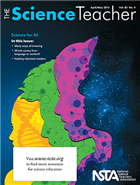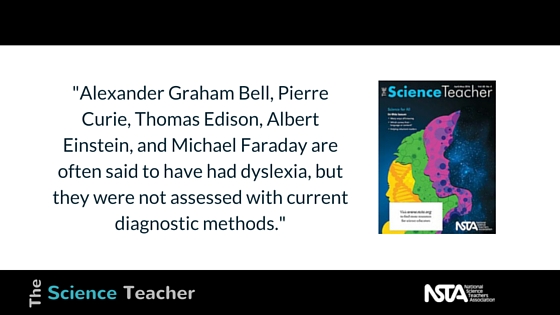Health Wise: Helping Students Cope With Dyslexia
By sstuckey
Posted on 2016-05-26
Parent groups have claimed that the specific needs of students with dyslexia—a learning disorder affecting the ability to read—are often unaddressed because educators don’t know enough about the condition. The parents also say schools can be reluctant to use the term in relation to learning disabilities addressed by the Individuals with Disabilities Education Act (IDEA). Recently, parent groups have been using the Twitter hashtag #saydyslexia to draw attention to their claims (see “On the web”).
The grassroots effort elicited a response from the federal government, saying that states, school districts, and educators should not avoid describing a particular student’s learning needs as related to dyslexia (OSERS 2015).
A step in the right direction
“There is nothing in… IDEA that would prohibit the use of the [term] dyslexia… in IDEA evaluation, eligibility determinations, or IEP [individualized education program] documents,” according to OSERS’s “Dear Colleague” letter to educators (OSERS 2015).
A student’s IEP “must be accessible to the regular education teacher and any other school personnel responsible for its implementation, and these personnel must be informed of their specific responsibilities related to implementing the IEP and the specific accommodations, modifications, and supports that must be provided.”
Dr. Bill Cassidy, a U.S. Senator from Louisiana, says the OSERS response “is a step in the right direction, but there’s still more work to be done. Scientific data shows that we can help students with dyslexia reach their educational potential by providing them with an evidence-based curriculum” (Cassidy 2015).
A common misconception
A common misconception about dyslexia is that letters or words seem reversed, such as the letter b appearing as d, says Dr. Mary Lou Gavin, senior medical editor for KidsHealth.org. “But the major problems with dyslexia are phonemic awareness, phonics, and rapid word recognition,” she says. “Dyslexia is not a visual problem. Dyslexia occurs because of subtle problems in information processing, especially in the language regions of the brain.”
To a person with dyslexia, Gavin says, words may seem like this:
Thew ord sare n otsp aced cor rect ly.
We spell wrds xatle az tha snd to us.
Sometimesallthelettersarepushedtogther.
Up to 17% of U.S. school-age children have dyslexia (Shaywitz 1998). When a comprehensive evaluation indicates a diagnosis of dyslexia, Gavin says, teachers can take steps to help, including
- offering reading assignments in audio formats;
- offering extra time for tests and homework;
- providing outlines, sharing notes, or recording lessons;
- providing customized learning aids and computer software; and
- connecting them with trained tutors.
“Students with dyslexia are often the target of bullies,” Gavin says. “Bullying and academic struggles could result in low self-esteem. It might be helpful to gently remind a student with dyslexia who’s struggling in class that the condition doesn’t mean he or she can’t achieve success in science.”
Famous people with dyslexia include Nobel Prize–winning molecular biologist Carol Greider, paleontologist Jack Horner, and polar explorer Ann Bancroft (YCDC 2016). Alexander Graham Bell, Pierre Curie, Thomas Edison, Albert Einstein, and Michael Faraday are often said to have had dyslexia, but they were not assessed with current diagnostic methods.
Michael E. Bratsis is senior editor for Kids Health in the Classroom. E-mail him with comments, questions, or suggestions.
On the web
For educators:
Factsheets on dyslexia, dyscalculia (learning problems related to math), dysgraphia (learning problems related to writing), and 63 other conditions that can affect learning: http://bit.ly/1TQalLl
Neural mechanisms in dyslexia: http://bit.ly/1Xg7kE8
SayDyslexia (SD): www.SayDyslexia.org
Study strategies for students with dyslexia: http://bit.ly/1Q5z2Uz
Teacher with dyslexia offers insight to fellow educators: http://bit.ly/1WaZ6vE
TED-Ed lesson on dyslexia: http://bit.ly/1y9Pfif
The Big Picture documentary film:
http://bit.ly/1aucmJ2
For students:
Bullying: http://bit.ly/1PM4Yep
Dyslexia: http://bit.ly/1T3FA4Y
Learning disabilities: http://bit.ly/1SG32qC
Self-Esteem: http://bit.ly/1dvg6pK
References
Cassidy, B. 2015. Cassidy: OSERS guidelines on dyslexia is a step in the right direction, but more needs to be done. http://1.usa.gov/20kpwfK
Shaywitz, S.E. 1998. Dyslexia. The New England Journal of Medicine 338: 307–312. http://bit.ly/1SEESN6
U.S. Department of Education’s Office of Special Education and Rehabilitation Services (OSERS). 2015. Dear colleague: Dyslexia guidance. http://1.usa.gov/1MJaskM
Yale Center for Dyslexia and Creativity (YCDC). 2016. An index of successful dyslexics. http://bit.ly/1xtRg8v
Editor’s Note
This article was originally published in the April/May 2016 issue of The Science Teacher journal from the National Science Teachers Association (NSTA).
Get Involved With NSTA!
 Join NSTA today and receive The Science Teacher, the peer-reviewed journal just for high school teachers; to write for the journal, see our Author Guidelines and Call for Papers; connect on the high school level science teaching list (members can sign up on the list server); or consider joining your p
Join NSTA today and receive The Science Teacher, the peer-reviewed journal just for high school teachers; to write for the journal, see our Author Guidelines and Call for Papers; connect on the high school level science teaching list (members can sign up on the list server); or consider joining your p
eers at future NSTA conferences.
The mission of NSTA is to promote excellence and innovation in science teaching and learning for all.
Future NSTA Conferences
NGSS Workshops
- Discover the NGSS, San Diego, June 29–30
- NGSS Summer Institute, Reno, July 15
- NGSS Summer Institute, Detroit, Aug. 8
- Discover the NGSS, Fall 2016 & Spring 2017
2016 STEM Forum & Expo
2016 Area Conferences
2017 National Conference
Follow NSTA
Disclaimer: The views expressed in this blog post are those of the author(s) and do not necessarily reflect the official position of the National Science Teaching Association (NSTA).


